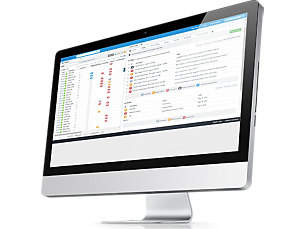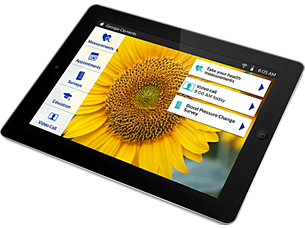- Patient participation and engagement
-
Patient participation and engagement
With the eSSC program, patients with chronic conditions have the professional support and resources they need to stay healthier out of the hospital. The following tools help keep patients in close contact with their care teams, and help them better understand and manage their own health: Daily health status surveys for subjective monitoring, customizable intervention measurements, personal messages from care team members and disease-specific educational content including video, quizzes and tips for improving lifestyle behaviors. - Behavioral science foundation¹
-
Behavioral science foundation¹
Extensive research on the lifestyle and communication habits of different patient demographics is built into the eSSC program along with input from behavioral scientists on patient motivations and health behaviors. This holistic approach to program design helps provide that patients receive personalized subject-matter and effective, confidence-boosting self-care strategies. - Clinical support and training
-
Clinical support and training
The eSSC program includes comprehensive support and training resources, including patient selection criteria setting; patient stratification tools, including surveys on medication compliance, nutrition and depression; and reporting for program administrators and physicians. - Patient education support
-
Patient education support
Audiovisual patient education programs leverage video and tablet technology to increase health literacy for patient populations. The use of less technical language combined with an interactive approach helps improve patient knowledge, self-care abilities and confidence; which can lead to behavioral changes that make a difference in health and quality of life. - Technology-powered communication
-
Technology-powered communication
Using two-way live video, clinicians can connect with and assess patients more accurately. This face-to-face interaction is designed to foster care plan compliance and help enhance diagnosis by providing immediate access to patient feedback. In addition, two-way video is designed to build patient self-care skill. - Implementation services
-
Implementation services
Our multi-disciplinary team of clinical and technical professionals delivers a range of services for program design and resource planning.
Patient participation and engagement
Patient participation and engagement
Behavioral science foundation¹
Behavioral science foundation¹
Clinical support and training
Clinical support and training
Patient education support
Patient education support
Technology-powered communication
Technology-powered communication
Implementation services
Implementation services
- eSSC program features and services
- Patient participation and engagement
- Behavioral science foundation¹
- Clinical support and training
- Patient participation and engagement
-
Patient participation and engagement
With the eSSC program, patients with chronic conditions have the professional support and resources they need to stay healthier out of the hospital. The following tools help keep patients in close contact with their care teams, and help them better understand and manage their own health: Daily health status surveys for subjective monitoring, customizable intervention measurements, personal messages from care team members and disease-specific educational content including video, quizzes and tips for improving lifestyle behaviors. - Behavioral science foundation¹
-
Behavioral science foundation¹
Extensive research on the lifestyle and communication habits of different patient demographics is built into the eSSC program along with input from behavioral scientists on patient motivations and health behaviors. This holistic approach to program design helps provide that patients receive personalized subject-matter and effective, confidence-boosting self-care strategies. - Clinical support and training
-
Clinical support and training
The eSSC program includes comprehensive support and training resources, including patient selection criteria setting; patient stratification tools, including surveys on medication compliance, nutrition and depression; and reporting for program administrators and physicians. - Patient education support
-
Patient education support
Audiovisual patient education programs leverage video and tablet technology to increase health literacy for patient populations. The use of less technical language combined with an interactive approach helps improve patient knowledge, self-care abilities and confidence; which can lead to behavioral changes that make a difference in health and quality of life. - Technology-powered communication
-
Technology-powered communication
Using two-way live video, clinicians can connect with and assess patients more accurately. This face-to-face interaction is designed to foster care plan compliance and help enhance diagnosis by providing immediate access to patient feedback. In addition, two-way video is designed to build patient self-care skill. - Implementation services
-
Implementation services
Our multi-disciplinary team of clinical and technical professionals delivers a range of services for program design and resource planning.
Patient participation and engagement
Patient participation and engagement
Behavioral science foundation¹
Behavioral science foundation¹
Clinical support and training
Clinical support and training
Patient education support
Patient education support
Technology-powered communication
Technology-powered communication
Implementation services
Implementation services
Empower chronic patients with better self-care approaches
The eCAC ambulatory telehealth program gives care teams the capability to monitor and coach high-risk chronic patients, helping them improve their ability to manage their own condition. Guidelines-based care plans are tailored for the unique needs of each patient, delivering a personalized experience for patients while enabling care teams to scale their efforts.

Philips telehealth programs with remote patient monitoring allow patients to track their vital signs from their homes and enables clinicians to make timelier care decisions.
Program features and services
The eCAC program combines clinical software and in-home technology that improve outcomes by fostering behavioral change. Customized care plans allow clinicians to set thresholds on incoming vital signs and survey replies, and send educational content to help empower patients to self-care.
Real-world results
Compared to traditional care, telemonitoring:
Telehealth is critically important to serve this large rural geographic area and provide access to home care and hospice. We know having the telehealth nurse work daily with high-risk patients enables us to reduce the frequency of trips to the home.”
-Lisa Harvey-McPherson, RN, Vice President of
Continuum of Care, Eastern Maine Health System
Related offerings
Related products
Alternative products
-
eCareCoordinator
- Patient and population management
- Patient communication and engagement
- Connected care and collaboration across the enterprise
- Empower patients to self-care
View product
-
eCareCompanion patient app
- Easy to use and intuitive
- Wireless connection
- Vital trends
- Glucose meters compatibility
View product
- 1.Debra Lieberman, Ph.D., Consultant, Evidence-Based Strategies for Improving Home Telehealth Educational Videos Users’ Health Behaviors,(2015)
- 2.Bashshur RL, et al. The Empirical Foundations of Telemedicine Interventions for Chronic Disease Management. Telemed and e-Health. 2014 Sept; 20(9):769-800.






